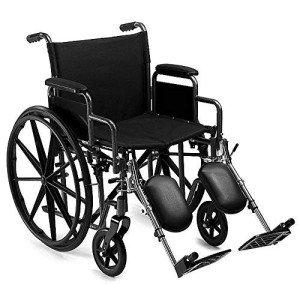Bariatric Wheelchair Seat Width
Seat Width
Having the proper seat width is essential to wheelchair users who spend longer periods in their chairs. Too narrow a seat will cause pressure on the hips and thighs which could lead to sores or pressure points. Having too broad a seat can likewise make it tough for the user to reach the hand rims to propel themselves or maneuver in small areas.
To measure the appropriate seat width a person would sit on a chair generally and have their measurement taken across their lap at the best point which is usually their hips. A wheelchair measuring tape can be utilized to determine this, but a backyard stick is preferred as it prevents individuals from covering the tape around their hips which would give an incorrect outcome.
The standard wheelchair seat width is 16" (narrow adult), 18" (basic adult), and 20" (broad adult). For bariatric patients, a 24" seat is available. This heavy-duty additional wide bariatric wheelchair from Medline features swing-away footrests, a carbon steel frame with rust- and chip-resistant chrome plating, and easy-to-clean vinyl upholstery. It has a weight capacity of 500 pounds.
Seat Depth
Typically, the seat depth of a bariatric wheelchair was added 2" to the measurement taken at the user's largest point (typically their hips). This was indicated to accommodate additional layers of clothes that may be worn during cold weather. However, this practice is becoming less typical as wheelchair users have the ability to invest more time inside and are not using long coats. This makes the seat depth of a chair less essential when picking a bariatric wheelchair. Nevertheless, it is still essential to choose an alternative that offers sufficient assistance for larger users.
The Medline folding extra broad bariatric manual wheelchair includes a comfortable 24" seat width and a sturdy slide tube silver vein frame. It likewise has an adjustable axle and tool-free raising legrests.
Seat Height
When it pertains to figuring out the right wheelchair seat width you should always determine from the user's best point which is usually their hips. You will also need to consider whether the user is going to be wearing a winter season coat as this might add 2" to the width needed.
When a wheelchair is in use it need to only be operated on level surface areas with the wheel locks fully engaged. This is to prevent the chair from being able to move slopes that are 10 degrees or higher. It is likewise essential to keep in mind that any activity that may shift the center of mass in the chair should be made with care. This includes grabbing items that need the individual to lean out of their seat or attempting to stand from it.
Whenever you have the chair in use it is recommended that you frequently examine it for damage and oil any areas that are deemed required. For instance, the casters must be oiled by eliminating the caster fork and utilizing a multi-purpose grease to use to the caster stem bearings. Likewise, bariatric wheelchairs uk can be changed by loosening the bolt and then moving them to the desired position. This enables the feet to sit easily on the footplate and avoids any pressure points from forming. This can be extremely unpleasant for the user and if left ignored, can result in push sores.
Weight Capacity
Bariatric wheelchairs are created to support more weight than standard wheelchairs. This makes them stronger and much better geared up to deal with falls. They are likewise typically bigger and wider, making them less maneuverable in tight spaces than basic wheelchairs. They require vehicles with unique ramps and lifts to fill them, as well as motorists who know how to finest transport them from one area to the next.

When choosing a wheelchair, consider its weight capacity as it will be the main determining consider whether it will accommodate your traveler's requirements. The weight capacity of the chair is typically noted as a fixed load, meaning that it suggests the amount of weight the chair can comfortably hold while stalling. However, some makers likewise list an active load that is based on a drop test and can mimic the impact of someone taking a seat in the chair. This might be a more dependable measurement of the weight limit, depending on your requirements.
If you plan to carry out activities that shift your center of mass in the seat (such as reaching for objects), be sure to have front casters pointed in a forward direction and wheel locks engaged so the chair will not topple. Also, examine that casters are lubed regularly to prevent extreme wear and abrasions. The lubrication procedure involves getting rid of the fork, separating the caster from the wheel, and greasing the caster stem bearings with top quality multi-purpose grease.
